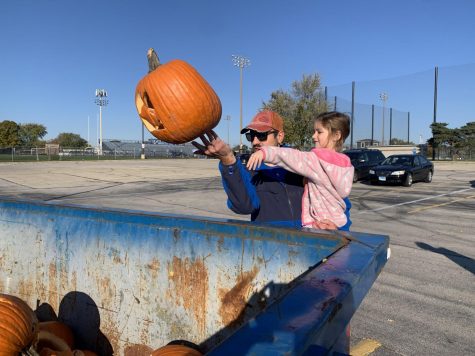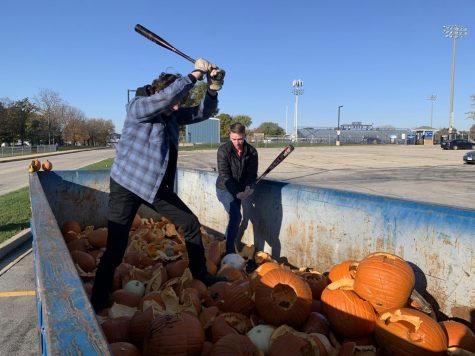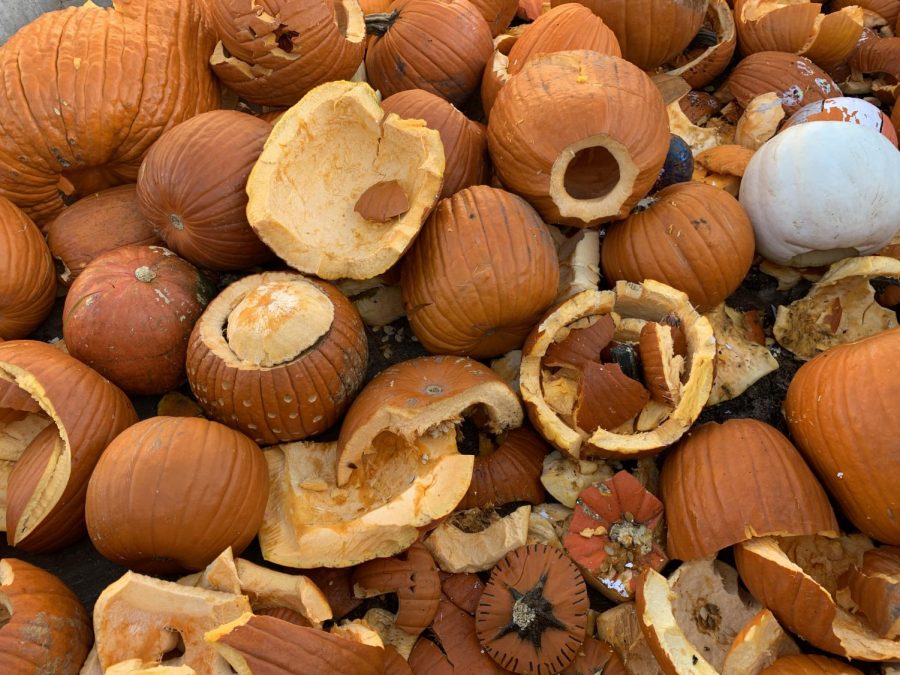Downers Grove community hosts pumpkin compost drive
The dumpster fills up quickly with all shapes and sizes of pumpkins. As a way to properly dispose of these pumpkins, residents acted sustainably by bringing them to the pumpkin drive at DGS.
The on-going tradition of six years, as the Downers Grove community likes to call the “pumpkin drive”, was hosted on Nov. 6, 2021 at DGS. Families and members of the Downers Grove community gathered to compost their pumpkins as a means to decrease waste creation generated from pumpkins when they end up in landfills or are left to rot on the streets.
The Downers Grove community was one of many pumpkin composting stations under the non-profit organization “SCARCE” which in total composted over 150 tons of pumpkins in 2020. With 31 pumpkin smashing sites across the state, the Downers Grove community continued their part in composting, ending up with over a dumpster full of pumpkins.
AP Environmental Science teacher Kathleen Troyer spoke upon the reasons as to why the pumpkin drive promotes good for the community and environment overall.
“I think it [the pumpkin drive] brings awareness, and I think people never thought about what happens to your pumpkin after you throw it out. I think a lot of people assume when things go, especially food to a landfill, it will decompose. Most of the time, some of the things don’t decompose because there’s not enough oxygen put into those systems,” said Troyer.
Recycling nutrients, water and other organic matter back into the soil is vital for the biochemical cycles to work. Instead, pumpkin waste generates detrimental greenhouse gas emissions such as methane and carbon dioxide, and when stuck in a landfill, pumpkins aren’t able to decompose to their full potential.
Troyer addressed that levels of methane and carbon dioxide are to be strictly viewed and controlled in landfills, yet when so many pumpkins are thrown out into garbage instead of compost sites, an overwhelming amount of these pumpkins are not able to be properly recycled back into the soil.
“If they [the pumpkins] go to a landfill, they are more likely to generate methane. Methane in the atmosphere causes more problems; it increases the greenhouse effect at a greater rate than carbon dioxide does. Hopefully by creating compost, instead of sending it to a landfill, we are making a little bit of a difference in terms of possibly reducing a small amount of greenhouse gasses into the atmosphere,” said Troyer.

Though jack-o-lanterns are displayed mainly as Halloween decorations, another AP Environmental Science teacher, Christine Tomanovich, acknowledged that pumpkins don’t only serve the purpose of the Halloween spirit. With water making up 90% of pumpkins, they don’t only become waste in landfills instead of fuel for soil; they also become a leftover food item.
“Pumpkins are just one example of organic waste that get thrown out as regular garbage and end up in a landfill. We can compost any organic matter, including most leftover food, yard trims, or leaves. Pumpkins are a fruit and food, and we don’t want them to be left to decompose in a landfill,” Tomanovich said.
Acknowledging the waste created from improper disposition of pumpkins is what the pumpkin drive strives to do, and there are many ways that surrounding communities and residents can start taking manageable steps and simple measures to reduce their pumpkins’ effects on the environment.

Senior Emily Poska, who attended the Downers Grove pumpkin compost drive, has gained many lessons just from attending the event and further looking into what she can do in her future to prevent her own, and others pumpkins from ending up in landfills.
“Next fall I can put my pumpkins to good use by getting their fullest potential out of them. I can enjoy them by carving them or making yummy toasted pumpkin seeds, but I also need to properly dispose of the pumpkin so it can continue to help our environment,” Poska said.
As people start to become increasingly aware of the need to properly discard their pumpkins, alongside other organic materials in the following autumn seasons, small community events like the pumpkin drive will start creating a bigger impact on the environment.
“Like everything we do, there’s a balance and if we can find a better way like composting these pumpkins as opposed to dumping them in a landfill; it’s a small success,” Troyer said.


